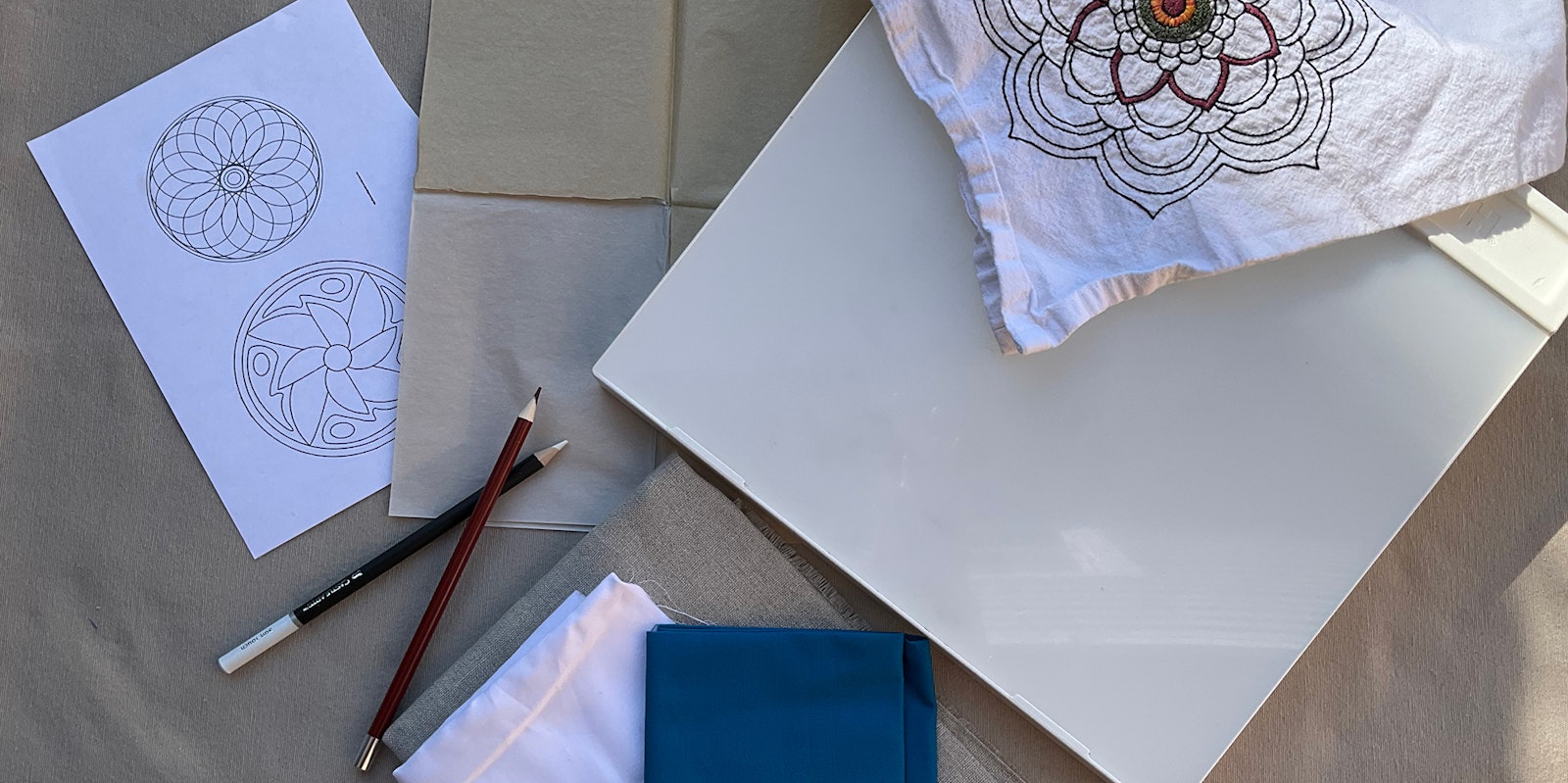Two of our embroidery PieceWork contributors, Melinda Sherbring and Deanna Hall West, shared additional information with their projects to make stitching easier! Here are their instructions for transferring designs to fabric for stitching.
How to Transfer a Needlework Design onto Light-Color Fabric
Melinda Sherbring
Materials for Tracing onto Light Fabric
- Design to be transferred
- Light source such as lightbox or window
- Printer/typing paper: white, 1 sheet
- Background fabric
- Painter’s or masking tape
- For tracing: washable fabric pen or pencil, or very sharp lead pencil
- For basting: sewing needle and sewing thread in a color that contrasts with your fabric; pins; stretcher bars or an embroidery hoop large enough to contain the pattern; and tweezers
A pattern can be transferred to the light-colored fabric in one of two ways: trace or baste. Basting is the recommended method on delicate fabrics.
Photocopy or trace the pattern onto thin paper. Tape the pattern to a lightbox or window. Center the fabric over the pattern, on grain, and tape it in place. Using a washable pen, washable pencil, or lead pencil, carefully trace the pattern onto the fabric.
To baste the pattern, place the linen fabric in the stretcher bars or an embroidery hoop, pulling it taut and straight. Pin the pattern atop the linen with the drawn lines of the edges on grain. Using sewing thread in a sharp embroidery needle, baste the lines of the pattern through the paper and the fabric. After the pattern has been transferred, remove the paper. Use tweezers to remove any last bits.
Notes
Whichever tracing method you use, on any color fabric, the marks must be covered by embroidery, as they do not always wash away or disappear.
 Detail of Melissa’s Glided Age Rose and Poms in Blackwork design featured in the Fall 2023 issue of PieceWork. Photos by Matt Graves unless otherwise noted
Detail of Melissa’s Glided Age Rose and Poms in Blackwork design featured in the Fall 2023 issue of PieceWork. Photos by Matt Graves unless otherwise noted
How to Transfer a Needlework Design onto Dark-Color Fabric
Deanna Hall West
Materials for Tracing onto Dark Fabric
- Design to be transferred
- Printer/typing paper: white, 1 sheet
- Background fabric
- Dressmakers carbon paper: white or yellow
- Painter’s or masking tape
- Blunt awl, size #18 tapestry needle, or empty ballpoint pen
- Quilter’s pencil: white lead
There are multiple ways and products to use to transfer a design to background fabric. Designs can be traced through light fabrics, but for dark fabrics the process is a little more complicated.
First, trace the design onto a sheet of white printer/typing paper. Using painter’s tape, firmly tape the fabric to a hard, flat surface (table), center and tape the dressmakers carbon paper to the fabric, and finally center and tape the traced design paper over the carbon paper. Using a blunt awl, size #18 tapestry needle, or empty ballpoint pen, firmly trace over the design. This transfers the design to the fabric. If part of the design on the fabric is faint, enhance it using a fine-point quilter’s pencil with white lead.
 Detail of Deanna’s Marguerite Daisies design featured in the Winter 2023 issue of PieceWork.
Detail of Deanna’s Marguerite Daisies design featured in the Winter 2023 issue of PieceWork.
Interested in working these projects? Melissa’s Glided Age Rose and Poms in Blackwork can be found in the Fall 2023 issue of PieceWork.
Deanna’s Marguerite Daisies: A Silk-Ribbon Embroidery Based on a Victorian Pelerine can be found in the Winter 2023 issue of PieceWork.
Also, remember that if you are an active subscriber to PieceWork magazine, you have unlimited access to previous issues, including Fall and Winter 2023. See our help center for the step-by-step process on how to access them.

